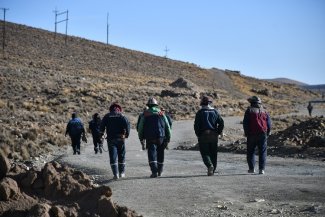Who or what will make up for the labour shortage in the world’s most aged country?
Turning 100 is no longer a novelty in Japan. Itsuko Inoue recently celebrated her 100th birthday, joining the ranks of Japan’s 71,000 centenarians. A native of Tokyo, Inoue survived both the earthquake of 1923 and the Second World War before going on to have five daughters. She will soon receive a certificate from Japan’s Ministry of Health, Labour and Welfare, which is responsible for congratulating the new centenarians who grow in number every year.
In September, Japan celebrated Respect for the Aged Day, a public holiday that pays tribute to the elderly for their contribution to the country and for their wisdom. An official from the Ministry came to Itsuko’s home to present her with her certificate. “It seems like quite a feat, doesn’t it?” says Itsuko’s daughter Miwako. “One day after another of living a normal life all while witnessing the history of the country.”
But behind this moving celebration, Japan, the world’s most aged country, faces a serious demographic problem and the government knows that finding sustainable solutions is a priority. According to data from the Japanese Ministry of Internal Affairs and Communications, those over 65 now number almost 36 million, 28.4 per cent of the country’s total population. According to the United Nations, Japan now has the world’s oldest population, ahead of European countries like Italy, Germany, Portugal and Finland, amongst others.
People in developed countries are living longer. Japan’s National Institute of Population and Social Security Research predicts that by 2040, 35 per cent of the country’s population will be senior citizens.
This alone shouldn’t be a problem for a society that takes pride in its elders and where respect and care for them is instilled from a very young age. But low birth rates and an alarming labour shortage threaten the sustainability of the country’s pension system and economy.
In 2018, 921,000 babies were born in Japan, the lowest number recorded since data started being collected in 1899 Prime Minister Shinzo Abe has referred to this as “a national crisis”. In order to increase the birth rate, the Japanese government will begin subsidising day-care for all children starting in October. But there aren’t enough public day-care centres and the waiting lists grow longer every year.
This lack of capacity is the biggest obstacle faced by Japanese women who decide to work after becoming mothers. In a society where the burden of care work falls on women, Japan’s lauded policy of ‘Womenomics’, intended to increase female labour participation, has been met with criticism as it has failed to make real progress.
Migrant workers: quick fix or sustainable alternative?
Long seen as a country wary of immigration, Japan reached a historic record in 2019. According to data from the Ministry of Justice, 2.7 million foreigners currently live in Japan (double the number from five years ago), 1.5 million of which are workers. In 2017, it ranked fourth out of all OECD member countries in receiving migrants.
Largely invisible to the average Japanese citizen, immigrants originating mostly from China, South Korea and south-east Asia came to Japan decades ago and became fixtures in sectors such as the restaurant business. Since 2008, with changes to the work visa system, they have become increasingly visible in the construction, agriculture, fishing and customer service industries.
Another large community consisting of Peruvians and Brazilians – most of them nikkei, or members of the Japanese diaspora whose ancestors arrived on the American continent at the beginning of the 20th century – have worked in the automobile and food industries within the framework of special bilateral agreements.
The Japanese Ministry of Foreign Affairs recently announced a budget allocation for the training of Latin Americans of Japanese origin in order to attract them into the workforce.
But too few are coming. Although the government repeatedly states that it does not have an immigration policy, the reality is different. According to Toshio Yanagida, professor at Keio University and expert in migratory movements between Japan and Latin America, “officially, the Japanese government has a labour policy rather than an immigration policy.” When asked how the country is evolving on questions of immigration, his response is critical: “Japanese society will continue to adjust to the situation without any direction or set destination, as it has done thus far.”
Faced with shortages in the workforce, the Japanese government enacted a reform of its labour policy that took effect in April, allowing for the entry of 345,000 low-skilled immigrants over the next five years to work primarily in construction, agriculture, fishing, healthcare and the service industry. This represents an expansion of the technical training programme that has already attracted 480,000 workers, mostly from China and south-east Asia.
The programme has been criticized for several reasons including the low salaries paid to workers, intermediary agencies that manage the arrival of migrants in exchange for debts, the fact that workers are not allowed to bring their families and not allowed to obtain permanent resident status. After five or ten years working in Japan, these migrants must return to their countries of origin.
Another piece of new legislation introduced in Japan is aimed at attracting highly qualified immigrants who are more easily able to renew their residencies and are allowed to bring their families with them. In 2008, a measure was approved for qualified foreigners to open start-ups in rural areas of Japan to combat depopulation.
Janine arrived three years ago from the Philippines on a five-year housekeeping visa. She left her children, ages 9 and 7, with her parents and lives in Tokyo with her aunt and a cousin. “I’m a single mother and my salary in the Philippines wasn’t enough. Here I’m able to support my children, help out my parents, pay my expenses and even save money. I’m a nurse but my visa doesn’t allow me to work in my field. Japan is very strict.” Janine plans to move to Canada where she can exercise her profession in English.
Although she studies Japanese and attends free classes provided by the local government, she does not have the level of written Japanese required to pass the exam that would allow her to work as a nurse. Japan grants permanent resident status to those who pass but very few are able to overcome the language barrier.
Nhung is a 25-year-old Vietnamese student who works part-time in a convenience store. Her Japanese is impeccable and she wants to stay once she finishes her studies. “I want to work for a Japanese company. Life here is comfortable and the salary is better.” She is one of 40,000 foreign workers employed at one of 55,000 such stores according to Konbini Gaikokujin, an essay by writer and economist Kensuke Serizawa, who toured the country researching immigration and social changes.
Serizawa believes that most Japanese people are just now beginning to understand the demographic problem, following the recent reforms. “Society neither welcomes foreign workers nor oppose them. The simply accept the situation,” he explains in an interview with Equal Times.
According to Serizawa, measures are lagging behind and there is a contradiction between the official discourse and the increase in the number of foreigners. “The government has accepted a considerable number under the technical training programme and as students. They are not officially recognised as workers and they are expected to one day return to their countries of origin so legal provisions for them to live in Japan are not being considered.”
Politicians steer clear of the subject of immigration. “It was hardly discussed during the elections to the upper house in July. It’s not popular and interactions with foreigners is still considered uncommon in Japanese communities,” says Serizawa.
He believes that a flexible society that accepts external stimulus will grow. “Japan is no longer the outstanding student of economics that it was in the second half of the 20th century. Vulnerable foreign workers should not be used as employment adjustment valves to deal with economic fluctuations.”
“Will foreign workers come even if Japan allows for a greater influx? There will be more and more competition between countries for this labour force. The visa system is complicated and unkind to those thinking of coming. Simply opening the door is not enough. Laws are urgently needed to build a society in which foreign workers, migrants, can live. It’s in the national interest,” Serizawa concludes.
Older retirees and robots
“It was more than just a supplement to my pension. I kept working to give something to the younger generations and because I felt good. I would have worked for even longer if it hadn’t been for my mother’s health.” Miwako, 73, was a teacher and school director. After her retirement, she worked for another nine years as an educational counsellor. She now takes care of her mother, our centenarian Itsuko. The term ro-ro-kaigo, which refers to elderly people who take care of elderly people, arose from a need to define these new realities.
In Japan, definitive retirement is relative. More and more people older than 65 remain in the workforce. The Japanese pension system makes it possible to combine pensions with income from employment.
The experience of these pensioners combined with the labour shortage make them an indispensable resource and they already represent 13 per cent of the workforce. There are 8.62 million of them, of which 3.5 million are women, a ratio that has been increasing for 15 years according to the Ministry of Home Affairs.
Faced with a low birth rate and an ageing population, the Japan Organisation for Employment of the Elderly (JEED), praised by the government and businesses alike, encourages “all people who have the desire and ability to work, including the elderly and persons with disabilities” to “exercise their abilities for their entire life in order to maintain the vitality of our economy and society.”
According to researcher Hiroshi Ishiguro, who runs a prestigious robotics laboratory at Osaka University, the use of robots will be a complement to care in an ageing society. “The Japanese government is focused on developing robots to help solve the physical problems of care. We go further and research communicative development.”
Telenoid, a small telematic robot that helps elderly people with dementia and is already in use in some homes, is his creation. Ishiguro highlights the benefits: “Robots are a communicative bridge between people and their caregivers. Elders feel pressure when talking to other people, but this is not the case when they interact with robots.”
He remains cautious about the uses and limits of robots in old age. “It’s just the beginning, we have to reduce costs in order to produce them in mass. It will [undoubtedly] be a lucrative market, there are many national and foreign companies interested.”










